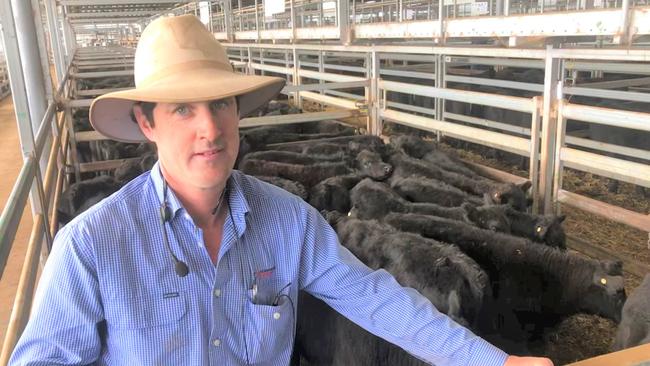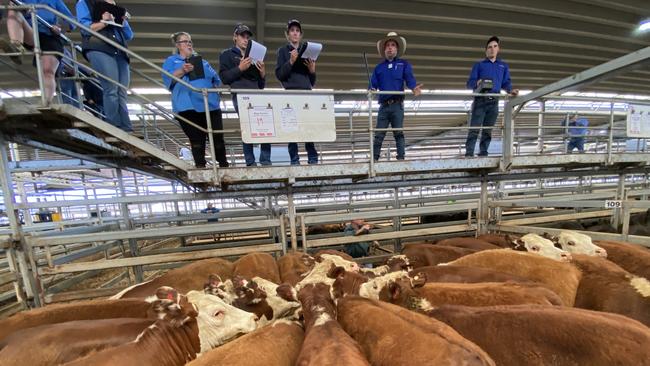Forecast rain offers hope for embattled livestock producers
Livestock producers are pinning their hopes on a rain-fuelled boost to markets, as values slip to lows not seen for years.
Livestock producers are pinning their hopes on a rain-fuelled boost to markets, as values slip to lows not seen for years.
The flow-on effects of poor prime values and talk of a drier-than-average El Nino weather pattern have spooked restockers, with many unwilling to take a punt on lambs, sheep or cattle.
If predicted rain does arrive across parts of southeast Australia this week, grass fever could change the outlook.
Confidence will be tested this week with about 10,000 store cattle to be offered in sales at Euroa, Wodonga, Mortlake, Wangaratta, Colac and Bairnsdale.
In southern NSW, the annual Jerilderie sheep sale will gauge the willingness of producers to restock while more than 50,000 sheep have been listed on online selling platform Auctionsplus.
Last week, Wodonga’s store market was rated as tough, with even the small offering of just 1148 cattle proving challenging to sell.
Corcoran Parker director Justin Keane said Victoria’s North East was having one of the best seasons in years as it had not been too wet, and with forecast rain this week, it could be even better.

Mr Keane said it was hard to comprehend why buyers had queued up to spend money in the past couple of years at high prices, but were not taking advantage of the much lower values now.
“Confidence seems to be shot,” Mr Keane said.
“It seems like those down south with feed are making the same kinds of destocking decisions as those up north who do not have feed, but we are not dry here and on the verge of the best spring in decades.”
Bidding at Wodonga started at less than $100 for some lines of Friesian steers with liveweight average prices slipping to just 223c/kg for steers and a paltry 157c/kg for heifers. The whole yarding averaged a sobering $634 a head.
Analysis by Meat and Livestock Australia shows producers are in major selldown mode for prime stock too as they grabble with either dry conditions or the fear they are coming.
MLA senior market information analyst Erin Lukey said year-on-year comparisons for September cattle numbers showed increases.
“Producers are turning off cattle significantly more than at the same time last year,” Ms Lukey said.
“Processor cow yardings are up 94 per cent, heavy steers are up 85 per cent and feeder steers are up 47 per cent.
“We can attribute this to the Australian herd sitting at 28.7 million, the largest for a decade, and possible producer concern following the BOM’s announcement of an El Nino.”
Lamb producers are also looking to shift stock – last week, the Victorian slaughter was 229,037 or the highest weekly Victorian lamb slaughter figure in NLRS records.
Finley sheep producer John Jamieson held a ram sale last week with a 81 per cent clearance and said it was a good result given that “everyone is extremely nervous”.
“Interest rates have gone up, the store market is down, there is the Western Australian live export situation and the BOM is talking El Nino, and combined this has had a significant impact on livestock markets,” Mr Jamieson said.
“It is not like southern areas are having a bad season and those further north have had three or four good ones in a row so you can’t expect that to keep going.
“But these kinds of prices for stock we are seeing now are going to put pressure on people, especially if they have borrowed money to buy stock,
“And it’s going to put pressure on property prices and the willingness of banks to lend money.”
Mr Jamieson said the current prices were hard to swallow.
“It is hard to get 1990 prices with 2023 bills,” he said.

Nutrien Casterton manager Rick Smith said the reluctance to restock was hard to work out.
“There are areas around here that are looking really good with feed and if we get 25mm of rain out of this change, it will get us through October,” Mr Smith said.
“But competition to restock is just not there – either in the yards or online.
“I had heifers on Auctionsplus that weighed 400kg and there wasn’t even a bid and it’s the same for Merino wether lambs and even prime lambs that would normally go to restockers are going straight to processors.”
Mr Smith said at the prices sheep and cattle were selling for at the moment, it should be the time when producers “step up”.
“Interest rates could have had a domino effect and maybe the ability to buy now and take a chance is not around as much as it was,” he said.




